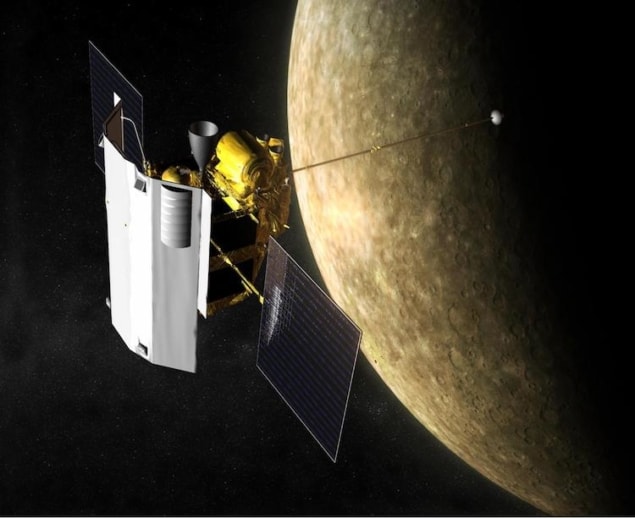Space-based spectrometer enters neutron lifetime debate
20 Jul 2020 Isabelle Dumé
While protons remain stable for at least 1034 years outside the nucleus, a free neutron survives for just under 15 minutes before it decays. The neutron’s precise lifetime is, however, a matter of some debate, as the two techniques commonly used to measure it have produced conflicting results of 880 and 888 seconds.
A team of researchers at the Johns Hopkins University Applied Physics Laboratory in the US led by Jack Wilson has now put forward a third, radically different technique that involves measuring the number of neutrons near a planet. Using data acquired by the neutron spectrometer on NASA’s MESSENGER spacecraft during flybys of Venus and Mercury in 2007 and 2008, they calculated the neutron lifetime to be 780 +/- 90 seconds. While this measurement has a large uncertainty, the researchers note that the MESSENGER instrument was never designed to perform studies of this type – meaning that a dedicated instrument on a future mission could produce a measurement with much higher precision.
Bottle and beam methods
The established techniques for measuring neutron lifetime are both laboratory-based. In the first, known as the “bottle” method, researchers use magnetic fields or mechanical forces to confine low-energy neutrons in a trap. They then count the number of particles remaining after a fixed period of time. In the “beam” method, they count the number of decay products – protons, electrons and antineutrinos – from a beam of neutrons.
The eight-second discrepancy between the neutron lifetimes measured using the bottle and beam methods has important implications for fundamental physics. For example, the neutron lifetime is a key parameter in studies of nucleosynthesis (element formation) in the Big Bang. Resolving this discrepancy (which has been blamed on unknown experimental errors) is therefore key to understanding how our universe formed 13.8 billion years ago.
The MESSENGER spacecraft’s neutron spectrometer was designed to measure Mercury’s surface composition, and to determine whether the planet’s poles might contain water ice. The instrument consisted of a 103 cube of borated plastic scintillator sandwiched between two 4-mm thick 100cm2 lithium-glass plates that are sensitive to neutrons created via the neutron capture reaction 6Li +n → 3H + 4He.
This reaction occurs when cosmic rays strike Mercury’s atmosphere or surface, so in effect, MESSENGER’s spectrometer measured the rates at which neutrons “leak out” from the planet. The number of neutrons detected depends on how long it takes the particles to “fly up” and reach the spacecraft’s neutron spectrometer. Hence, the shorter the neutron’s lifetime, the fewer the neutrons that survive long enough to reach the detector.
Venus flybys
Before MESSENGER entered Mercury’s orbit, it went through a series of flybys of Earth, Venus and Mercury. During the second Venus flyby, its neutron spectrometer was switched on to check that the instrument was working properly. The data used in this study, which is published in Physical Review Research, were taken during this Venus encounter and during MESSENGER’s first flyby of Mercury.
Venus’ atmosphere is both simple and relatively uniform, containing mainly carbon dioxide (96% by volume) and nitrogen (most of the remainder). Because MESSENGER made observations over a large range of heights above the planet’s surface, the researchers were able to measure how the neutron flux changes with distance.
“The basis of our measurements is a set of models of the neutron production, propagation and detection during these flybys that are modelled with different lifetimes,” Wilson explains. “The shorter the neutron lifetime, the more rapidly the neutron counts decrease with altitude and the model that best fits the data gives us the lifetime.”
A “giant bottle experiment”
The researchers describe their spacecraft-based technique as being conceptually like a giant bottle experiment, one that uses Venus’ gravity to confine neutrons for periods comparable to their lifetime. However, they emphasize that its systematic uncertainties are completely different from those of previous measurements. This, they argue, is potentially a big advantage, as the most likely cause of the disagreement between the beam and (conventional) bottle techniques is that one or both of them underestimated or missed a systematic error
The work is a proof-of-principle demonstration that such an approach is at least possible, Wilson tells Physics World. More progress might be made using other planetary neutron spectrometer data sets, but he suggests that the best path forward would be to design a dedicated instrument on a future mission optimized to measure neutron lifetime from orbit. Venus, he adds, is a good candidate in this respect thanks to its thick atmosphere and large mass that effectively traps neutrons.
“The main thing that held our measurement back was the short time MESSENGER spent at Venus (roughly 45 minutes),” he says. “If we could spend a longer time there, we could improve the statistics of the measurement and avoid introducing the systematics associated with using the data from this spacecraft.”
from physicsworld.com 23/8/2020

Δεν υπάρχουν σχόλια:
Δημοσίευση σχολίου